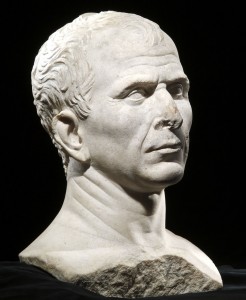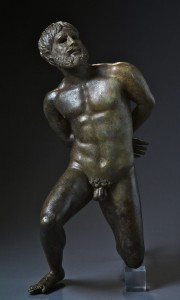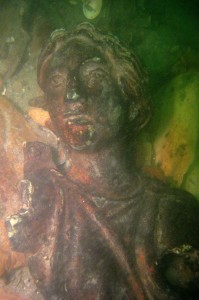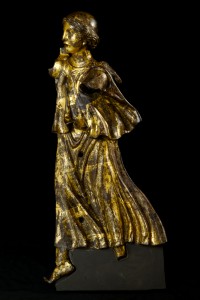 The bust of Caesar found in the Rhône river has gone on display in the Arles museum along with many other Roman artifacts salvaged from the river.
The bust of Caesar found in the Rhône river has gone on display in the Arles museum along with many other Roman artifacts salvaged from the river.
The new exhibit at the Arles museum covers not just the remarkable contemporary bust of Julius Caesar, carved during his lifetime in 46 B.C. and portraying him as the middle aged guy he was, but also 500 other artifacts, the fruits of 20 years of perilous and frustrating dives in the Rhône.
The murky waters, strong currents and local fauna made these dives hard work. The team were ready to give up, in fact, when they found the bust of Caesar. After that, of course they had renewed purpose. They’ve been salvaging major Roman artifacts as recently as this year.
The “unifying theme” in “Caesar, the Rhône for Memory”, running to September 2010, is “to maintain the feeling of going on a journey with the archaeologist, following every stage of their work from the site of the digs right up to the restoration and exhibition of the artifacts”, says its designer Pierre Berthier.
The collection shows ancient Arles was not only a port and place of passage, but “decorated” and “monumental” says Long, “an ostentatious facade aiming to display Rome’s wealth and power”.
The most stunning finds are together in the last room of the exhibition that Long calls “the saint of saints”.
Alongside Caesar is the 1.8-metre (six-foot) marble statue of the god Neptune dating from the beginning of the third century AD, and a bronze satyr with its hands tied behind its back.
There’s also a bronze Victory, a head of Juno or Venus, piles of metal ingots, tools, amphorae, oil lamps, an assortment of slice-of-life remnants from 15 different shipwrecks.
When the exhibit ends next September, all the artifacts on display will be added to the museum’s permanent collection.
Photos courtesy of the Musée départemental Arles antique © Maby J.-L. & Roux L.



Don’t forget to mention the copyright of these photos :
Musée départemental Arles antique © Maby J.-L. & Roux L.
Thanks !
Done! :thanks:
nice pictures of Julius Caesar bust discovered in Arles France in 2007 on this website http://www.arles-guide.com/arles_photo_tour/archaeological_exhibition_caesar_the_rhone_for_memory_in_arles
i am a poobum :notworthy:
BACK THEN, IT WAS VERY DIVERSE. ROMAN WAS NOT ETHNICITY…. EVERYONE IN THE ROMAN REPUBLIC LOOKED LIKE TODAY MANY BLACKS TOO YES. Conquered people also were given Roman citizenship. TODAY Roman is someone who embraces the culture, born there, doesn’t matter at all your ethnicity. Like Americans who put ethnicity to your identity so much, most of the world does not they go by class and your nationality. Well same in the ancient days, it was diverse believe it or not. EVEN SOME BLACK EMPERORS. IT WAS DIVERSE AND NO ONE LOOKED A LIKE. HE HAD PIERCING EYES, THIS DEFINITELY LOOKS LIKE CAESAR TO ME. THE ROMANS LIKED TO IDEALIZE BEAUTY….SO STATUES DIDN’T ALWAYS PORTRAY THEM EXACTLY. WHY YOU THINK AUGUSTUS HAD HIS PORTRAIT CHANGED TO LOWER HIS BROWS LIKE CAESAR… SAME WITH CLEOPATRA. HER COIN WAS PROPAGANDA, A WAY TO SHOW PEOPLE SHE COULD LEAD! SHE WAS HALF BLACK AS HER SISTER WAS BLACK AND GREEK, SHE WAS MOST LIKELY BLACK AND GREEK. EGYPTIANS THEN WERE BLACK YES… AND SOME TIMES SLAVES HAD BABIES WITH ROYALTY. HER MOTHER IS UNKNOWN AND REMEMBER HER FAMILY LIVED IN EGYPT FOR YEARS! SHE WAS OF PETITE STATURE FOR SURE THERE’S REFERENCES TO IT. THIS REALLY LOOKS LIKE CAESAR TO ME AND PEOPLE SHOULD QUIT ACTING FAKE AND IDEALIZING HIM, HE WAS HUMAN AND A REAL MAN. A breathing real person.
Arles is proving to be a treasure trove! The Cesar bust is fascinating and detail is outstanding. We own replicas of several Roman figures, including a small Cesar. However we had never seen this ‘more accurate, aged face.’
Now, we await a big display of the newly discovered murals from the area. We can hardly wait till TOMORROW to look at pieces of YESTERDAY!